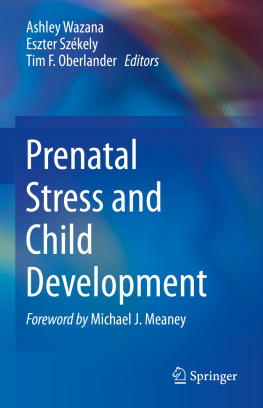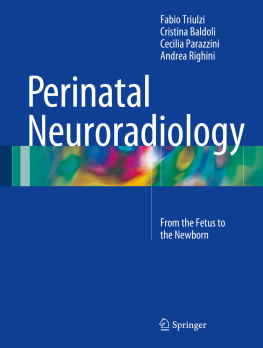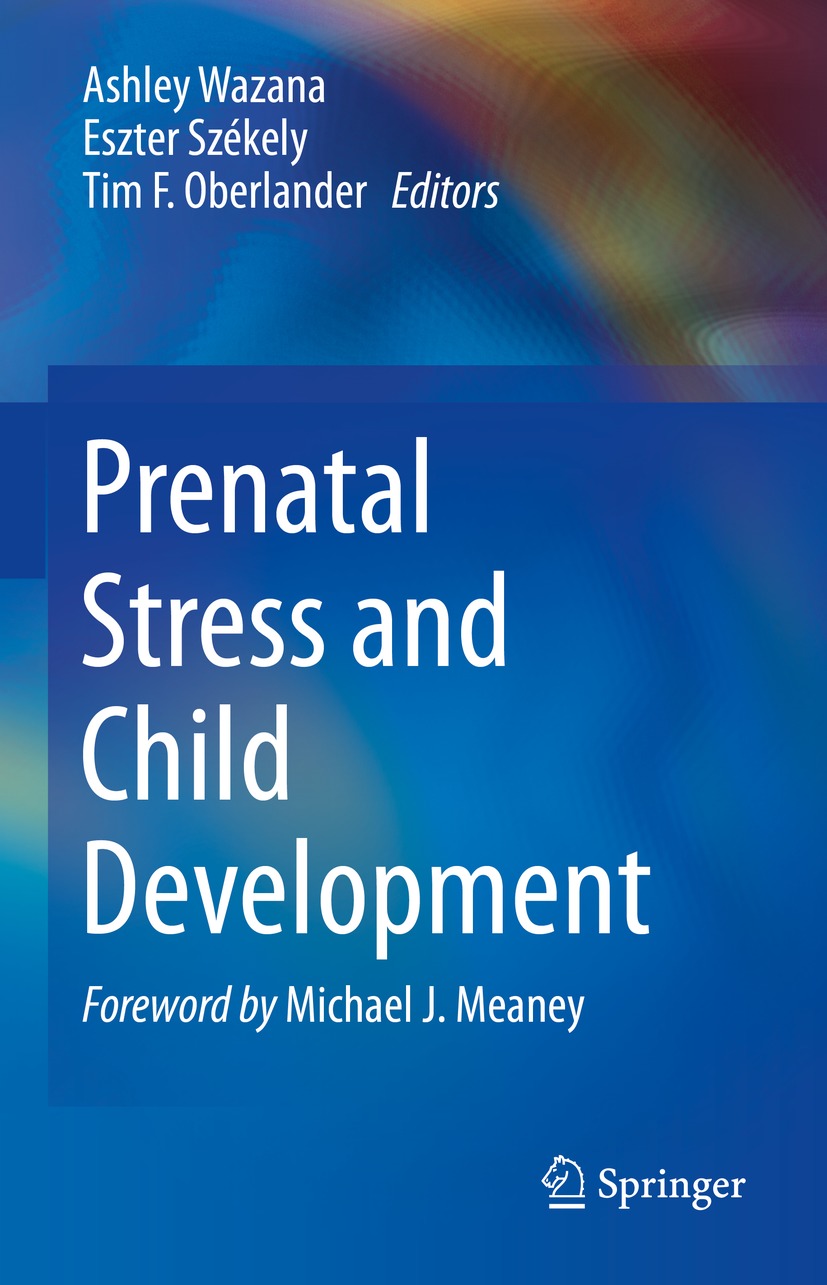Editors
Ashley Wazana , Eszter Szkely and Tim F. Oberlander
Prenatal Stress and Child Development
1st ed. 2021
Foreword by Michael J. Meaney

Logo of the publisher
Editors
Ashley Wazana
Department of Psychiatry, McGill University, Montreal, QC, Canada
Lady Davis Institute for Medical Research, Jewish General Hospital, Montreal, QC, Canada
Eszter Szkely
Department of Psychiatry, McGill University, Montreal, QC, Canada
Lady Davis Institute for Medical Research, Jewish General Hospital, Montreal, QC, Canada
Tim F. Oberlander
BC Childrens Hospital, BC Womens Hospital and Health Centre, Vancouver, BC, Canada
Department of Pediatrics Faculty of Medicine, University of British Columbia, Vancouver, BC, Canada
ISBN 978-3-030-60158-4 e-ISBN 978-3-030-60159-1
https://doi.org/10.1007/978-3-030-60159-1
Springer Nature Switzerland AG 2021
This work is subject to copyright. All rights are reserved by the Publisher, whether the whole or part of the material is concerned, specifically the rights of translation, reprinting, reuse of illustrations, recitation, broadcasting, reproduction on microfilms or in any other physical way, and transmission or information storage and retrieval, electronic adaptation, computer software, or by similar or dissimilar methodology now known or hereafter developed.
The use of general descriptive names, registered names, trademarks, service marks, etc. in this publication does not imply, even in the absence of a specific statement, that such names are exempt from the relevant protective laws and regulations and therefore free for general use.
The publisher, the authors and the editors are safe to assume that the advice and information in this book are believed to be true and accurate at the date of publication. Neither the publisher nor the authors or the editors give a warranty, expressed or implied, with respect to the material contained herein or for any errors or omissions that may have been made. The publisher remains neutral with regard to jurisdictional claims in published maps and institutional affiliations.
This Springer imprint is published by the registered company Springer Nature Switzerland AG
The registered company address is: Gewerbestrasse 11, 6330 Cham, Switzerland
We dedicate this book to Klaus Minde, Michael J. Meaney, and our parents.
Foreword
I have always looked to the foreword for a reply to the simple question of why should I read this book? I have formulated this foreword accordingly. The quality and breadth of the science described in this compilation begs a broad audience. I thus admit to lapsing into a degree of editorializing directed specifically to colleagues in the basic sciences, and in particular neuroscience, to establish streams of research on prenatal stress and neurodevelopment that would complement the impressive advances realized with humans. However, my comments to this audience apply equally well to any student of human child development and suggest that you should read this book in its entirety.
The epidemiological observation of the association between birth weight and the lifetime risk of cardio-metabolic disease led David Barker to popularize the idea of fetal origins for adult disease. The resulting developmental origins hypothesis created widespread interest in physiology and clinical medicine for the importance of the prenatal environment in determining health across the lifespan. In truth, research in child development and psychiatric epidemiology (and see below) predated the Barker hypothesis. More recently, the landmark findings from mature, longitudinal cohort studies and those with high-risk samples, the integration of technological innovations into the study of child development, and conceptual and computational advances, all so well described in this volume, have collectively established the study of the prenatal environment as perhaps the most exciting area in the science of child development. So, the short rationale for why you should read this book is that it is the first major compilation of the contemporary science dedicated to the topic of prenatal stress and child development, and the chapters are almost exclusively based on recent research findings from an impressive list of contributors covering an equally impressive range of topics, with contributions that are at the conceptual and methodological forefront of research in child development. The longer version of the rationale follows.
The study of prenatal influences on brain development and function occupies a unique niche in the history of the behavioral sciences. Research in human child development up to the 1990s generally reflected a rather poor understanding of the origins of individual differences in social, emotional, and cognitive function as well as vulnerability for mental disorders. The field was plagued by the deep and misguided distinction of biological vs social sources of variation in brain function and mental health. The argument was something of a proxy battle for the naturenurture controversy. It was widely assumed that the essential architecture of the brain emerged during early perinatal development in accordance with a genetic blueprint. The hardware was thus established and considered invariant, save for anomalies associated devastating and thankfully rare neurological conditions. The prevalent understanding assumed that individual differences in social, emotional, and cognitive functions emerged postnatally through processes linked to various forms of learning and memory. The environmental forces thus created the software that drove the genetically prescribed neural hardware to produce inter-individual variation. The reader will immediately note that this approach, apart from its conceptual pitfalls, provided no position whatsoever for the importance of gene x environment interactions not to mention an appreciation of prenatal environmental influences.
The notion that variation in socio-emotional traits occurred solely as a product of postnatal factors was modified in the 1970s when Thomas and Chess reported stable, inter-individual differences in temperament in human newborns (researchers seem to have been that last group of people on earth to have come to this realization!). The landmark, longitudinal studies of Jerome Kagan confirmed temperamental variation in infants and charted both the stability of such differences and their meaningful relation to later anxiety disorders. However, the interpretation of such findings remained embedded in the prevailing, stultified understanding of neurodevelopment. The forces acting prior to birth were still considered uniquely as biological in origin, linked to the genetic blueprint and the influence of which lay beyond the reach of environmental influences. Since variation in temperament appeared in newborns, it was assumed ipso facto to be the product of biological (i.e., genetic) influences. The irony here is that the anxiety disorders presaged by the variations in temperament are among the least heritable of all brain-based disorders.
A more informed insight into the biology of prenatal neurodevelopment emerged, in large part, from two streams of science. The first were studies of prenatal stress in rodents and nonhuman primates (e.g., Schneider & Moore, 2000; Coe et al 2003; Weinstock, 2008). Rigorously controlled studies that included postnatal cross-fostering provided unequivocal evidence for the importance of the maternal environment on neuroanatomy and brain function. These studies bore the merit of systematic experimental manipulations using a range of behavioral tests and what were at that time state-of-the-art neuroscience techniques. Stress imposed on the mother during pregnancy produced an enduring signature on brain structure and function. Cross-fostering studies precluded associated complications of the postnatal environment (see Hartman and Belsky in this volume for a more nuanced version of this issue). These studies provided compelling evidence for environmental effects on fetal neurodevelopment.










